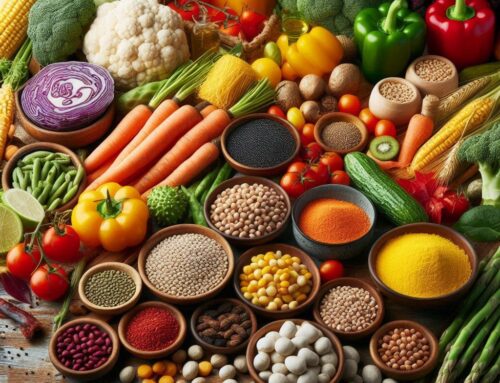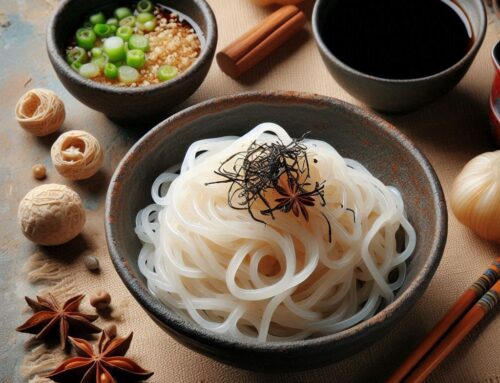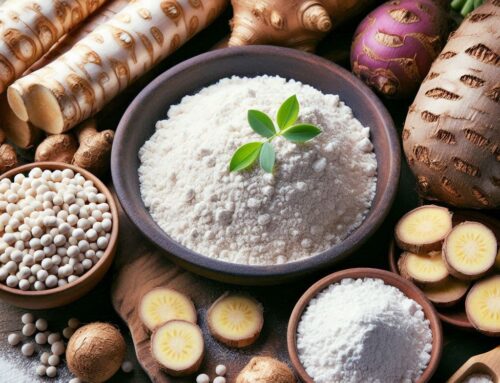
Introduction to Konjac Jelly: What It Is and Why It’s Trending
Konjac jelly has recently emerged as a trending food, captivating the attention of health enthusiasts and foodies alike. But what exactly is konjac jelly, and why has it gained such popularity? At its core, konjac jelly is derived from the konjac root, a plant native to parts of Asia. Known for its high fiber content and low-calorie profile, this unique ingredient has been traditionally used in Asian cuisine for centuries.
One of the primary reasons konjac jelly is making waves in the modern diet scene is its potential as an effective weight loss aid. The glucomannan fiber found in the konjac root expands in your stomach after consumption, promoting a feeling of fullness that can help curb overeating. This makes it an appealing option for those seeking meal replacement solutions without sacrificing nutritional value.
As more people search for convenient ways to manage their weight while enjoying tasty treats, konjac jelly stands out with its versatility and health benefits. From snack packs to dessert alternatives, this innovative product continues to trend due to its ability to satisfy cravings while supporting dietary goals. Whether you’re looking for a new addition to your weight management plan or simply curious about novel foods, exploring the world of konjac jelly might just be worth your while.
Nutritional Profile of Konjac Jelly: What Does It Contain?
Konjac jelly has gained popularity as a health-conscious snack, but what exactly does its nutritional profile look like? At the heart of konjac jelly’s appeal is its primary ingredient, glucomannan—a type of dietary fiber known for its impressive ability to absorb water and expand in the stomach. This characteristic not only promotes a feeling of fullness but also aids in digestion, making it an excellent choice for those looking to manage their weight or improve digestive health.
When examining konjac jelly nutrition facts, one of the standout features is its low-calorie content. Typically, a serving contains just a few calories, making it an ideal option for those monitoring their caloric intake. Despite being low in calories, konjac jelly doesn’t compromise on providing essential nutrients. While it may not be rich in vitamins and minerals compared to other foods, it often contains small amounts of important nutrients like calcium and iron depending on additional ingredients or fortifications.
Incorporating konjac jelly into your diet can be beneficial due to the presence of glucomannan fiber. This unique fiber not only supports digestive health but also helps regulate blood sugar levels and cholesterol when consumed regularly as part of a balanced diet. As you explore this intriguing food option, keep in mind that while it’s nutritious in certain aspects, it’s best complemented by other nutrient-dense foods to ensure a well-rounded intake of vitamins and minerals.
The Health Benefits of Incorporating Konjac Jelly into Your Diet
Konjac jelly, a popular dietary choice for those seeking health improvements, offers a range of benefits that make it an excellent addition to your daily routine. One of the most notable health benefits of konjac jelly is its positive impact on digestive health. Rich in glucomannan, a natural dietary fiber, konjac jelly can aid digestion by promoting regular bowel movements and alleviating constipation. This high-fiber content helps maintain a healthy gut flora balance, which is essential for overall digestive wellness.
In addition to supporting digestive health, konjac jelly plays a significant role in cholesterol reduction. The soluble fiber in konjac can bind with bile acids in the intestine, facilitating their excretion and thereby lowering blood cholesterol levels. This process not only contributes to heart health but also reduces the risk of cardiovascular diseases.
Moreover, incorporating konjac jelly into your diet can be beneficial for blood sugar control. The glucomannan fiber slows down the absorption of carbohydrates and sugars in the bloodstream, leading to more stable post-meal blood sugar levels. This makes konjac jelly an ideal option for individuals managing diabetes or those looking to prevent blood sugar spikes.
Overall, the inclusion of konjac jelly in your diet can provide substantial advantages across various aspects of health—making it a versatile and valuable component for anyone looking to enhance their well-being naturally.
The Potential Downsides and Considerations of Relying on Konjac Jelly as a Meal Replacement
Konjac jelly has gained popularity as a meal replacement option due to its low-calorie content and ability to promote a feeling of fullness. However, there are potential downsides and considerations that consumers should be aware of before relying on it as a primary dietary staple.
One major concern is the nutritional profile of konjac jelly. While it is effective in reducing calorie intake, it lacks essential nutrients such as proteins, vitamins, and minerals that are crucial for maintaining overall health. Relying solely on konjac jelly could lead to nutrient deficiencies over time if not supplemented with other nutritious foods.
Additionally, the high fiber content in konjac can cause digestive issues for some individuals. Consuming large amounts might lead to bloating, gas, or even intestinal blockages in severe cases. It’s important for users to introduce konjac products gradually into their diet and monitor any adverse reactions.
Moreover, while konjac jelly can aid weight loss by curbing appetite, it’s vital to approach weight management holistically. Incorporating balanced meals rich in diverse nutrients alongside regular physical activity will yield more sustainable results than relying exclusively on meal replacements.
In conclusion, while konjac jelly offers certain benefits as part of a calorie-controlled diet plan, it’s essential to consider these potential downsides and ensure that it complements rather than replaces a well-rounded diet. Consulting with healthcare professionals or nutritionists can provide personalized guidance tailored to individual dietary needs and goals.
How to Effectively Use Konjac Jelly in Your Daily Meal Plan?
Integrating konjac jelly into your daily meal plan can be a game-changer for those looking to manage their calorie intake while still feeling satisfied. Known for its low-calorie content and high fiber, konjac jelly is an excellent addition to any diet. Here are some effective tips on how to incorporate this versatile ingredient into your meals.
Firstly, consider using konjac jelly as a base for salads or stir-fries. Its neutral taste allows it to absorb the flavors of other ingredients, making it an adaptable component in various dishes. Pairing it with colorful vegetables and lean proteins not only enhances the nutritional value but also keeps the meal light yet filling.
Another way to integrate konjac is by substituting it for higher-calorie ingredients in traditional recipes. For instance, use konjac noodles instead of regular pasta or rice in your favorite dishes. This swap not only reduces the overall calorie count but also helps in satisfying hunger due to its high fiber content.
To maximize the benefits of konjac jelly, plan your meals ahead of time by incorporating these swaps throughout your week. This strategic approach ensures that you have healthy, low-calorie options readily available, helping you stay on track with your dietary goals without compromising on taste or satisfaction.
By following these meal planning tips and integrating konjac with other foods effectively, you can enjoy a diverse range of satisfying meals while maintaining a focus on health and wellness.
User Experiences: Success Stories and Testimonials from Those Who Tried a Konjac-Based Diet
Exploring the diverse range of satisfying meals while maintaining a focus on health and wellness can be both exciting and rewarding. One increasingly popular approach is incorporating konjac-based foods into one’s diet. This unique ingredient, derived from the root of the konjac plant, is celebrated for its low-calorie and high-fiber properties, making it an excellent choice for those seeking to manage their weight without sacrificing satisfaction.
Success stories and testimonials from individuals who have embraced a konjac-based diet highlight its potential benefits. Many have reported significant weight loss while enjoying delicious meals that keep them full longer. For instance, Sarah, a busy professional, shared how substituting traditional pasta with konjac noodles helped her shed unwanted pounds without feeling deprived. Similarly, Mark found that incorporating konjac rice into his meals allowed him to maintain his energy levels throughout the day while sticking to his dietary goals.
These personal accounts underscore the versatility of konjac as a dietary staple that aligns with health and wellness objectives. By integrating this ingredient into various recipes—from stir-fries to soups—individuals can enjoy a wide array of flavorful dishes that support their journey towards better health. Whether you’re looking to lose weight or simply enhance your nutritional intake, exploring konjac-based options could be a transformative step in achieving your wellness aspirations.
Conclusion: Is Konjcac Jelly the Right Meal Replacement for You?
In conclusion, Konjac jelly presents an intriguing option as a meal replacement for those seeking to manage their weight or incorporate more dietary fiber into their routine. When considering its suitability, it’s important to weigh both the pros and cons.
On the positive side, konjac jelly is low in calories and high in glucomannan, a dietary fiber that can promote feelings of fullness and potentially aid in weight loss. Its convenience makes it an appealing choice for busy individuals looking for a quick meal solution without compromising on nutritional goals.
However, there are also considerations to keep in mind. As with any meal replacement, relying solely on konjac jelly may not provide all the essential nutrients your body needs. It’s crucial to ensure that your overall diet remains balanced and varied. Additionally, some people may experience digestive issues when consuming large amounts of fiber-rich foods like konjac jelly.
Ultimately, whether konjac jelly is the right meal replacement for you depends on your personal health goals and dietary needs. Consulting with a healthcare professional can provide personalized advice to help you make an informed decision about incorporating this product into your lifestyle.






